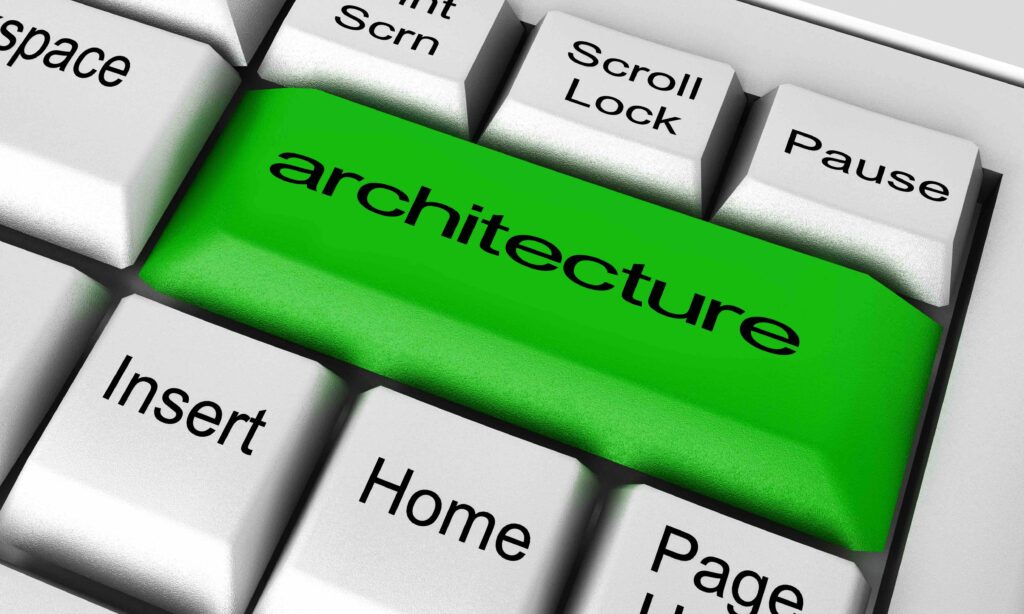Let’s begin by understanding the concept of software architecture before delving into its design processes.
Software architecture encompasses a software system’s design, organization, and interactions and its components and modules. It involves making decisions about the system’s structure, behavior, performance, and other qualities to ensure that it meets its functional and non-functional requirements. A well-designed software architecture can improve the system’s maintainability, scalability, reusability, and overall quality.

Types of Software architecture and how to choose one:
Several types of software architecture exist, including Monolithic, Client-Server, Microservices, Event-Driven, and Service-Oriented.
Architecture choice depends on project size, complexity, scalability, team skills, and budget. Architects evaluate these factors to determine which architecture best fits the project.
For instance, a monolithic architecture is suitable for small to medium-sized projects with limited scalability requirements. Conversely, microservices suit large, complex projects with high scalability requirements.
Similarly, client-server architecture is ideal for projects that require a centralized database, while event-driven architecture is best for projects that require high throughput and low latency.
Overall, architects consider various factors when choosing the architecture that best fits the project’s needs.
Now that we understand software architecture and its types, let’s delve into the design process.
Designing software architecture is a complex process that requires careful planning, analysis, and design. Here is a complete guide on how to design software architecture:
Define the project scope:
Define the project’s scope, goals, and objectives. This involves identifying the purpose of the software, the target audience, and the functional and non-functional requirements.

Conduct research and discovery:
Conduct research and discovery to identify potential opportunities, challenges, and risks associated with the project. This phase involves assessing project feasibility, analyzing market demand, identifying the target audience, and evaluating competitors.
Gather requirements:
Gather requirements by eliciting, analyzing, and validating stakeholder information. Comprehensive information about the software’s requirements is collected through various techniques, such as interviews, surveys, and workshops. These requirements are then analyzed and validated through stakeholder review and approval, ensuring the software meets their needs and expectations.
Design software components:
Architects play a crucial role in designing the different components or modules. These components are building blocks that perform specific tasks and work together to create the final software product. The architects must consider the software’s requirements and design each component accordingly. This includes determining the specific functionality each component will provide and any interactions it may have with other components.

Define software structure:
Define the software’s overall structure by organizing the data, designing user interfaces, and ensuring information flows smoothly through the system. By carefully considering these factors, architects can help create software that is efficient, user-friendly, and capable of meeting the needs of its users.
Choose technologies:
Determine the technologies and tools used to build the software. This involves evaluating the project’s requirements and selecting the most suitable programming languages, databases, frameworks, and other necessary software components.
Ensure scalability:
Consider the possibility of growth and increased usage in the future to ensure that the software can handle a more significant number of users or data without any major drop in performance. This process, called scalability planning, is essential to ensure the software’s long-term viability and sustainability.
Consider security:
Design the software with security measures to protect against threats and vulnerabilities.
Create documentation:
Create detailed documentation that outlines the design decisions, the structure of the software, and how various components interact. This documentation is a valuable resource for developers responsible for implementing the software and ensuring it meets the project’s requirements.
Architects usually require several documents for software development. Some of the important ones include:
- Software Requirement Specification (SRS) document: This document outlines the software’s requirements, including functional and non-functional requirements.
- Architecture Design document: This document outlines the high-level design of the software, including the software architecture, database design, and user interface design.
- Technical Design document: This document outlines the detailed design of the software, including the algorithms, data structures, and other technical aspects.
- Test Plan document: This document outlines the testing strategy for the software, including the testing approach, test cases, and expected results.
- User Manual document: This document outlines the usage instructions for the software, including how to install, configure, and use the software.
- Clear and concise documents detailing software requirements, design, and testing are essential to ensure the end-users needs are met during software development.
By following these steps, you can design a well-structured, efficient, and scalable software architecture that meets the needs of its users.
Conclusion:
Designing a software architecture is crucial in developing any software application. It determines the system’s functionality, performance, and maintainability. To create a successful software architecture, adopt a systematic approach and consider the application’s requirements, design principles, development methodology, and available technologies. By implementing best practices of software architecture design, developers can create efficient software systems that meet users’ needs and add value to businesses.
